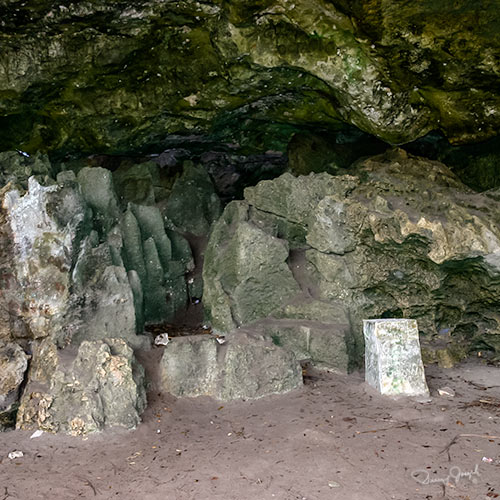Historic Site Discovered 1600s
Along with the island of Eleuthera, Preacher's Cave was discovered in the 1600s by Captain William Sayles. The placard at the entrance of the cave says “William Sayle shipwrecked at Devil Backbone found refuge here. Sermons held 100 years.” The cave is located approximately 10 miles from North Eleuthera Airport and is on the north shores of Eleuthera adjoining a long and broad sweeping beach called Tay Bay Beach. ![]()
We can visualize the first discovery of Preacher's Cave from Everild Young's book Eleuthera: “One can imagine the two tiny ships feeling their way southward with their cargoes of hopes and aspirations, the sea bright, sparkling in the sunshine, and then all of a sudden producing one of those appalling storms that the islanders today call “a rage”. They must have sailed too close to the reefs bounding the northern tip of Eleuthera on the Atlantic side of the island, and been caught by a sudden change of weather.”
Whether the quarrelling on board had an effect in disturbing the navigation of the ships, we do not know, nor is it certain where, exactly, the wreck took place. But it cannot have been far from the northernmost point, now called Ridley's Head ![]() , as the castaways are said to have sheltered in a large cave in a bluff near the shore, a little way down the coast, known as Preacher's Cave.”
, as the castaways are said to have sheltered in a large cave in a bluff near the shore, a little way down the coast, known as Preacher's Cave.”

How To Get To The Cave
Preachers Cave is fairly easy to get to. Take Queen's Road through North Eleuthera till it ends. A sign there indicates Spanish Wells to the West and Preachers Cave to the East. You fill find another sign along the way that points to the North. The cave is accessible by land by following a narrow path from a road that follows along the northern shore of Eleuthera.
There has been renewed interest in Preachers Cave after an archaeological dig, headed by the site's Chief Archaeologist Bob Carr, unearthed remains of what is thought to be a Lucayan Indian lying close to the remains of a 350-year-old Eleutheran Adventurer. The Bahamian government said it hoped to convert the famous cave into a national park.
“The roof of the cave is pierced by several large bores or chimneys which must have been caused by the action of the sea long ago. The place is certainly capacious enough to have accommodated the seventy settlers, and the floor is comparatively dry.”

About the Caves On Eleuthera
“The larger of the two ships and all the provisions were lost, but only one life, and the unfortunates who sheltered in Preacher's Cave were forced to subsist on any wild fruit they could fine, and possibly managed to procure some fish. But their condition was desperate, and the aged parson, Patrick Copeland, is presumed to have died as a result of the appalling conditions on arrival.”
Caves on Eleuthera were created by the dissolution of carbonate sands. These appear to have been formed in a combination of typical down flow of surface water creating karst sinkhole terrain. The caves here have been formed during past periods of lower sea level; with sea level rise, the caves have been flooded and presently lie both above and below the water table. The lowest level of caves contains salt water. Floating above this in both caves and cenotes is a relatively thin layer of surface fresh water. Above this is the zone of air-filled cave or open sinkhole.
The second method of cave modification occurs with the constant flushing of tidal seawater into and out of the caves below sea level, washing out and hollowing the rock beneath the ground. Along the coast, this continuing erosion produces swim-throughs and water caverns.
Where there is limestone you will always find caves, and Eleuthera possesses plenty of them, from end to end.

